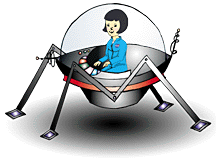![]()
 |
Guess what?Asteroids are often referred to as minor planets or planetoids.
|
| An asteroid is a rocky body in space which may be only a few hundred feet wide or it may be several hundred miles wide. They are considered to be debris left over from the formation of the solar system. Many asteroids orbit the Sun in a region between Mars and Jupiter. This "belt" of asteroids follows a slightly elliptical path as it orbits the Sun in the same direction as the planets. It takes anywhere from three to six Earth years for a complete revolution around the Sun. An asteroid may be pulled out of its orbit by the gravitational pull of a larger object such as a planet. Once an asteroid is captured by the gravitational pull of a planet, it may become a satellite of that planet. Astronomers theorize that is how the two satellites of Mars, Phobos and Deimos, came to orbit that planet. An asteroid is also capable of colliding with a planet resulting in the formation of an impact crater. Some scientists believe that just such an impact in the area of the Yucatan Peninsula in Mexico started the chain of events which led to the extinction of the dinosaurs here on Earth. Astronomers think that if it were not for the giant planet Jupiter exerting its gravitational force on the asteroids in the belt, the inner planets would be constantly bombarded by large asteroids. The presence of Jupiter actually protects Mercury, Venus, Earth, and Mars from repeated asteroid collisions! |
|
A QuestionWhat prevents the asteroids in the belt from plunging towards the Sun and hitting the inner planets in the process? |
| Did you know? |
The Answer |
![]()
| Show me the Level 1 version of this page. |
The StarChild site is a service of the High Energy Astrophysics Science Archive Research Center (HEASARC), within the Astrophysics Science Division (ASD) at NASA/ GSFC.
StarChild Authors: The StarChild Team
StarChild Graphics & Music: Acknowledgments
StarChild Project Leader: Dr. Laura A.
Whitlock
Curator:
Responsible NASA Official: